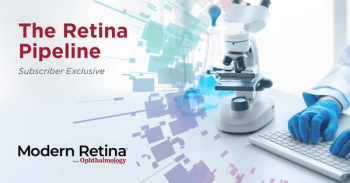
Innovations fuel sustained drug-delivery methods for AMD
A variety of newer drug delivery approaches may change how patients with age-related macular degeneration are treated.
Take-home message: A variety of newer drug delivery approaches may change how patients with age-related macular degeneration are treated.
Reviewed by Peter K. Kaiser, MD
Cleveland-Both ophthalmologists who treat age-related macular degeneration (AMD) and their patients are eager to find new ways of treatment that go beyond the current routine of anti-vascular endothelial growth factor (VEGF) injections.
Several newer methods of drug delivery-including biodegradable polymers, reservoir implants, and encapsulated cell technology-are under investigation as future approaches, said Peter K. Kaiser, MD, Chaney Family Endowed Chair in Ophthalmology Research, Cole Eye Institute, Cleveland Clinic, Cleveland.
The new approaches would need to match the effectiveness of anti-VEGF injections.
“We know that fixed dosing with anti-VEGFs gives us the best treatment response and the best visual acuity,” said Dr. Kaiser, Chaney Family Endowed Chair in Ophthalmology Research, Cole Eye Institute, Cleveland Clinic, Cleveland.
“Any deviation from that standard reduces visual acuity outcomes,” he said. “The problem is, doctors don’t want to give that many injections, and patients don’t want to receive them.”
Biodegradable polymer
One new approach involves putting the target drug into a polymer matrix via a biodegradable polymer, which slowly releases the drug.
“In the past, emulsion technology was used to release particles,” Dr. Kaiser said. “The problem with this technology is that the particles are variable in size. This matters because size determines the release characteristics.”
Modern polymer technology may enable this approach more frequently in the future.
Multilayer liposomes
Another approach is multilayer liposomes, which have different layers with drugs in them.
“As the lipid layer breaks down, the drug is released. By adjusting the phospholipid formulation, you can adjust release characteristics and duration of release from the technology,” Dr. Kaiser said.
Reservoir implants
A third drug-delivery approach for AMD involves reservoir implants. In one scenario, the drug is loaded into a micropump and is slowly released into the eye-if necessary, it could provide medication as often as once an hour, Dr. Kaiser said.
The reservoir can hold 4 to 9 months of the drug, and the reservoir is refillable as an in-office procedure. Programming of the pump could be done wirelessly.
A similar concept that is in phase II trials with ranibizumab is a port-delivery system that releases the drug slowly and diffuses it over 3 to 4 months. This system involves a long-term drug delivery implant inserted with a 3.2-mm scleral incision. The patient returns to the office every 3 to 4 months to refill the medication.
Additional approaches
Other approaches under investigation include gene therapy, which offers the hope of unlimited release of the drug; and encapsulated cell technology, which involves a semipermeable cylinder that has altered retinal pigment epithelial cells.
The final approach that Dr. Kaiser outlined was using the choroid as a depot, during which physicians use a microcatheter or microneedles to inject drugs into the suprachoroidal space.
“There are a variety of approaches to improving drug delivery in AMD,” Dr. Kaiser said. “Intravitreal injections and sustained-release solid implants are the most common techniques used at the present time. Advances will continue to occur, along with the development of new agents.”
It still is unclear which of these approaches will pan out for patients the best, he added.
Peter K. Kaiser, MD
This article was adapted from Dr. Kaiser’s presentation during Retina Subspecialty Day at the 2015 meeting of the American Academy of Ophthalmology. Dr. Kaiser discloses financial interests with Aerpio, Alcon Laboratories, Alimera Sciences, Allegro, Bayer Healthcare Pharmaceuticals, Biogen, Digisight, Genentech, Kanghong, Novartis Pharmaceuticals, Ohr, Ophthotech, Regeneron, Santen, and ThromboGenics.
Newsletter
Keep your retina practice on the forefront—subscribe for expert analysis and emerging trends in retinal disease management.















































